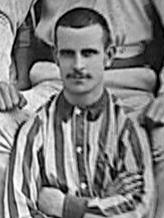Route to the final
Blackburn Rovers

Following their debut in 1879–80, this was the seventh time Blackburn Rovers played in the FA Cup. Having been runners-up in 1881–82, they had won the competition in both 1883–84 and 1884–85. Blackburn began the 1885–86 tournament with an away tie [note 1] at nearby Clitheroe. They won this 2–0 and then had three successive home ties before being awarded a bye through the fifth round (the last sixteen) to the quarter-finals. They were drawn away to Brentwood at the Essex County Cricket Ground where Blackburn won 3–1 to reach the semi-finals. This match, played on 13 March at the Derbyshire County Cricket Ground, was against Swifts. Blackburn won 2–1 with goals scored by Nat Walton and Thomas Strahan. [1]
| Round | Opposition | Score |
|---|---|---|
| 1st | Clitheroe (a) | 2–0 |
| 2nd | Oswaldtwistle Rovers (h) | 1–0 |
| 3rd | Darwen Old Wanderers (h) | 6–1 |
| 4th | Staveley (h) | 7–1 |
| 5th | bye | |
| 6th | Brentwood (a) | 3–1 |
| Semi-final | Swifts (n) | 2–1 |
West Bromwich Albion

West Bromwich Albion made their FA Cup debut in 1883–84 and this was their third season in the competition. They were drawn at home in every round prior to the semi-final. In the first two rounds, they defeated Aston Unity 4–1 and Wednesbury Old Athletic 3–2. They received a bye to the fourth round, where they beat Wolverhampton Wanderers 3–1. Old Carthusians were defeated by a single goal in the fifth round. A hat-trick from Jem Bayliss—the first by an Albion player in the FA Cup [2] —contributed to a 6–0 quarter-final victory over Old Westminsters, putting Albion into the FA Cup semi-final for the first time (they had reached the quarter-final in 1884–85). The semi-final took place at Aston Lower Grounds and was against one of Albion's local rivals, Small Heath Alliance. Albion won 4–0—Arthur Loach and George Woodhall each scoring twice—to become the first Midlands club to reach the FA Cup Final. [3] After the game, Small Heath supporters invaded the pitch and then pelted missiles at vehicles bound for West Bromwich, causing several injuries. [4]
| Round | Opposition | Score |
|---|---|---|
| 1st | Aston Unity (h) | 4–1 |
| 2nd | Wednesbury Old Athletic (h) | 3–2 |
| 3rd | bye | |
| 4th | Wolverhampton Wanderers (h) | 3–1 |
| 5th | Old Carthusians (h) | 1–0 |
| 6th | Old Westminsters (h) | 6–0 |
| Semi-final | Small Heath Alliance (n) | 4–0 |